Next hearing / pre-trial conference: Weds, Nov 20, 2024 –
Case No. 231000299 (Case of Military Service Claims) — CITY OF FARMINGTON vs. RONALD WAYNE MAKIN
Listen to radio show host Maggie Rose interview Ron about his military service.
Help exonerate Ron Makin!
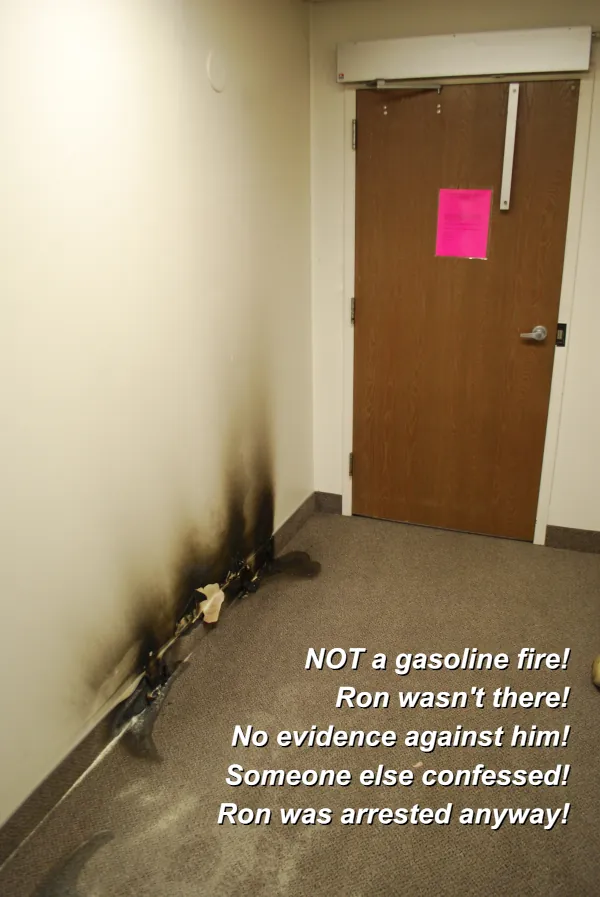
- Ron Makin was falsely accused and convicted of starting a fire, but …
Ron wasn’t near the property and there was ZERO evidence that he was involved in starting the fire. - Investigators allege it was a gasoline fire, but …
ALL of the fire-related evidence refutes their claim of gasoline. - The Prosecution couldn’t produce any evidence that 1) Ron was on site during ignition, nor 2) that it was a gasoline fire.
- No one smelled gasoline inside the building and the fire caused almost NO damage, but investigators blamed Ron for the fire because Ron smelled like gasoline and had gasoline in the back of his truck. Their reasoning doesn’t add up!
- The minimal damage, negligible heat, the lack of a gasoline odor, and the fire’s characteristics are all quite contrary to what a professional fire investigator would expect from a gasoline fire — therefore, it wasn’t a “gasoline” fire!
- The residents along the burning hallway didn’t act like it was hot, and they didn’t panic.
- The fire self-extinguished within a few minutes of the alarm’s activation, except for the few remaining patches of fire which Ron helped extinguish.
- Officers and fire fighters said that the fire was out before they arrived.
- The indoor and outdoor surveillance footage failed to show Ron near the Meadows property around the time the fire started.
- Someone obviously leaked the flammable liquid (likely alcohol from a leaking garbage bag) along the hallway and stairwell within moments of the fire’s ignition, but that particular footage from the surveillance cameras has not been provided.
- When the Meadows fire started, Ron was witnessing a documented traffic stop a half-mile away from the Meadows. He described this traffic stop several times in multiple officer videos.
Above, the most ferocious visuals of the fire (of the provided footage) in the hallway. (The fire in the adjacent stairwell fully self-extinguished.)
Watch Utah’s ABC 4 News with Marcos Ortiz’s coverage of this case, one year after the fire. The fire was on May 19, 2018. You can read the full news story at https://www.abc4.com/news/the-justice-files-good-samaritan-becomes-suspect-in-apartment-fire/.
Change.org Petition: Exonerate innocent Ron Makin for baseless arson charges! Read about Ron’s harrowing ordeal.
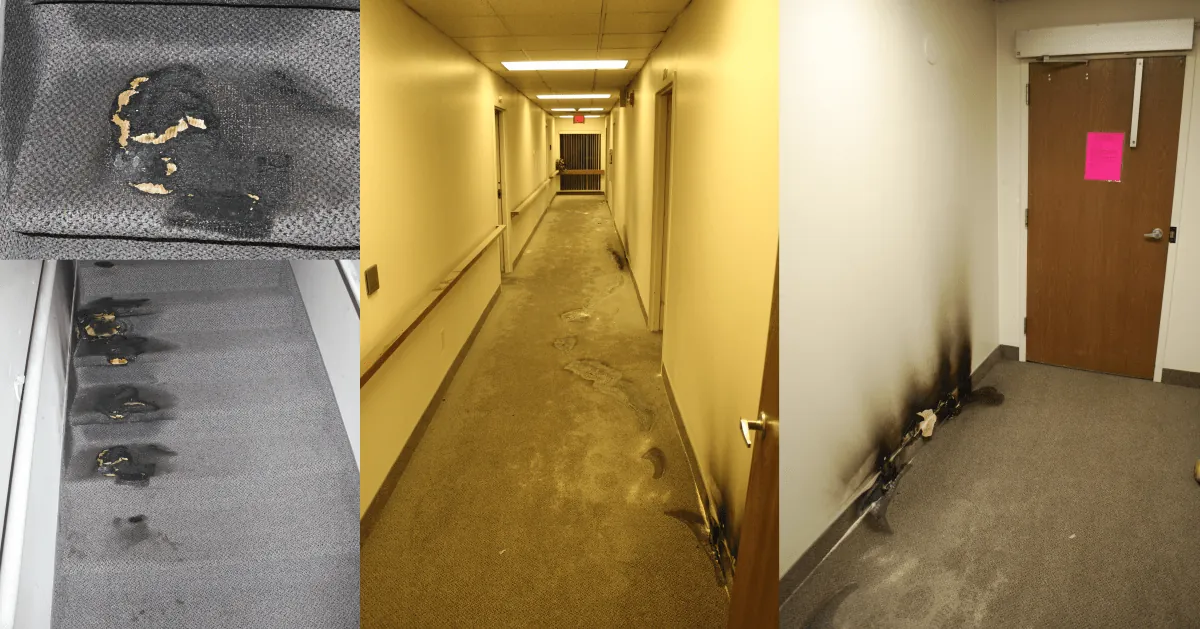
Ron Makin — a man with communicative and physical disabilities from a childhood traumatic brain injury (TBI), who was wrongly charged for starting a Meadows apartment building fire that caused almost no damage, and of which the absence of him in building surveillance footage near the fire area, and a distant, documented pullover, both clearly demonstrate he wasn’t around to have anything to do with starting the fire. Ron, a Meadows resident, was falsely accused, detained and arrested on the night of the fire, May 19-20, 2018.
The Meadows (west building) is the home of ~50 disabled and handicapped people. Ron was one of those residents, along with his wife.
Summons – Aug 9, 2023: Bootstrapped charges originating from Ron’s “arson trial,” alleging that he falsely claimed he served as a Marine.
Recent hearing: October 4, 2023. (See court calendar.)
The Third Step: Square & circular shapes burned into the third-to-last step before the stairwell’s exit door?! It is the end of the trail of an alcohol-like flammable liquid leaked along the hallway & stairwell. This was a garbage bag leak — the exit door leads to a nearby dumpster. Ignition of that liquid was accidental.
The Surveillance Footage, & the Lack of It: All of the provided footage from Prosecution, plus camera maps & lines of sight of surveillance cameras.
Facts that refute the investigators’ claims: All of the evidence indicates that it wasn’t a gasoline fire and that Ron wasn’t involved in starting the fire.
Fire Stairwell’s Window: The stairwell window is always visible when approaching the building from the only road, yet no officers, firemen, or residents reported seeing any flames through the window.
Audio of 911 Phone Calls: Ron & others reporting the fire.
Ron’s Cigarette Lighter: Ron bought a cigarette lighter for a BBQ, but officers didn’t find it in his pocket (contrary to their claims), and there’s no evidence to connect it to the fire.
Ron’s Psychological Evaluation
The Brady Rule: By law, investigators & Prosecution must provide all evidence that would help Ron’s defense. They didn’t.
Outside the north wing, and a view into its stairwell after the fire:
Was the Meadows Apartments fire a violent gasoline fire, or simply a ‘small,’ alcohol-drip, carpet fire accident?
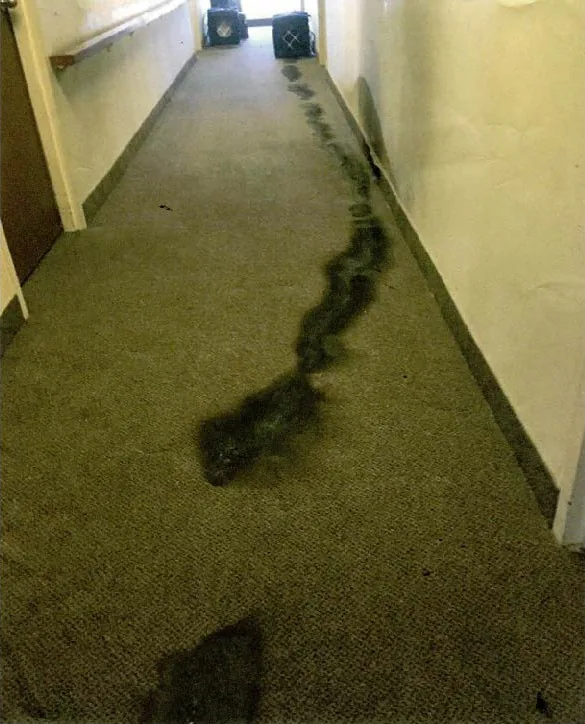
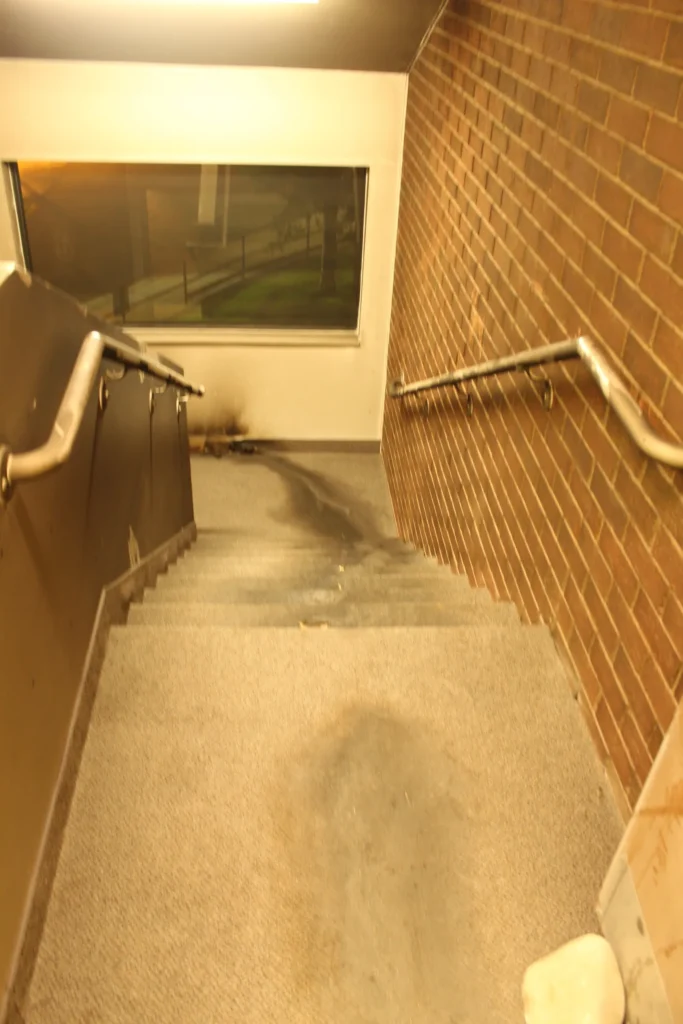
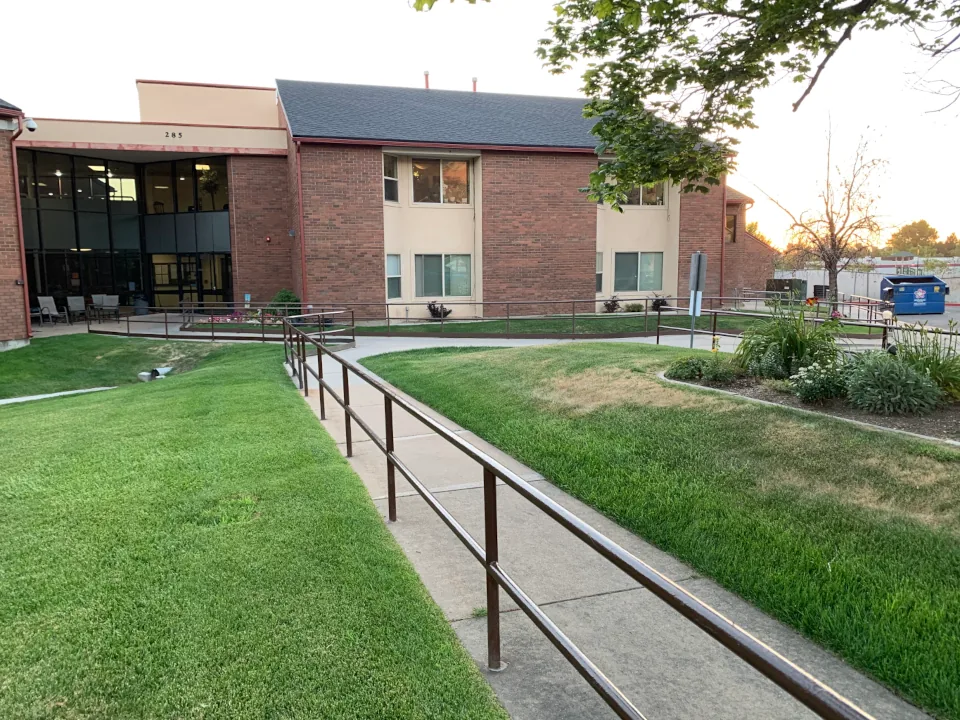
Investigators claim that the small carpet fire was intentional and that it was a gasoline fire. The burn path looked looks like a garbage bag leak, and the path leads to the outside dumpster. In the dumpster was a Budweiser box to hold beers, which means alcohol was at least present inside the building.
Was Ron Makin a malicious villain, or a caring hero?
Though Ron Makin was accused, charged, convicted, and sentenced for starting the fire,
- There is NO footage of Ron on or near the property within 15+ minutes before and after the fire ignited, nor any witnesses claiming to have seen Ron there around that time.
- At the time the fire ignited, Ron was not near the property but was witnessing a traffic stop a half-mile away, which he could not have known of or described to the officers that night if he had not been there and seen that pullover.
- There is NO evidence that even approaches “beyond a reasonable doubt” that Ron was involved in contributing to or causing the fire.
- Ron made no attempts to flee. Ron was not concerned on the night of the fire when he was arrested, because he believed that all of the surveillance and other evidence would exonerate him and prove his innocence.
Investigators claim it was a gasoline fire, but
- No one reported smelling gasoline inside the building at any time, before or after the fire. Gasoline reeks to high heaven! A liquid was leaked along the full length of the hallway where three of the hall’s residents exited (evacuated) from the hall, and it is impossible that they did not notice a gasoline odor if gasoline had been present!
- The fire was OUT before fire fighters arrived!
- The fire did NOT burn with the ferocity and duration of gasoline. There was NO fireball! There was almost no damage. The fire did NOT flash with searing heat, violently explode, or present a propelling shockwave as is consistent with gasoline.
- There has not been ANY footage provided or witness of anyone (including Ron) entering or exiting the fire area—with or without a container of liquid—after Ron exited that area at 10:08 and before the fire alarm activated at 11:47. That is a 1-hour 40-minute gap where a flammable liquid was spilled and ignited but supposedly where no record exists of anyone having entered the area to distribute or ignite that liquid!
- No forensic report has suggested and substantiated that gasoline residue was present in the evidence samples collected at the scene.
The investigators claim it was a gasoline fire, but here’s an actual gasoline fire near Detroit, Michigan https://www.youtube.com/watch?v=-1PmbvVx2vI :
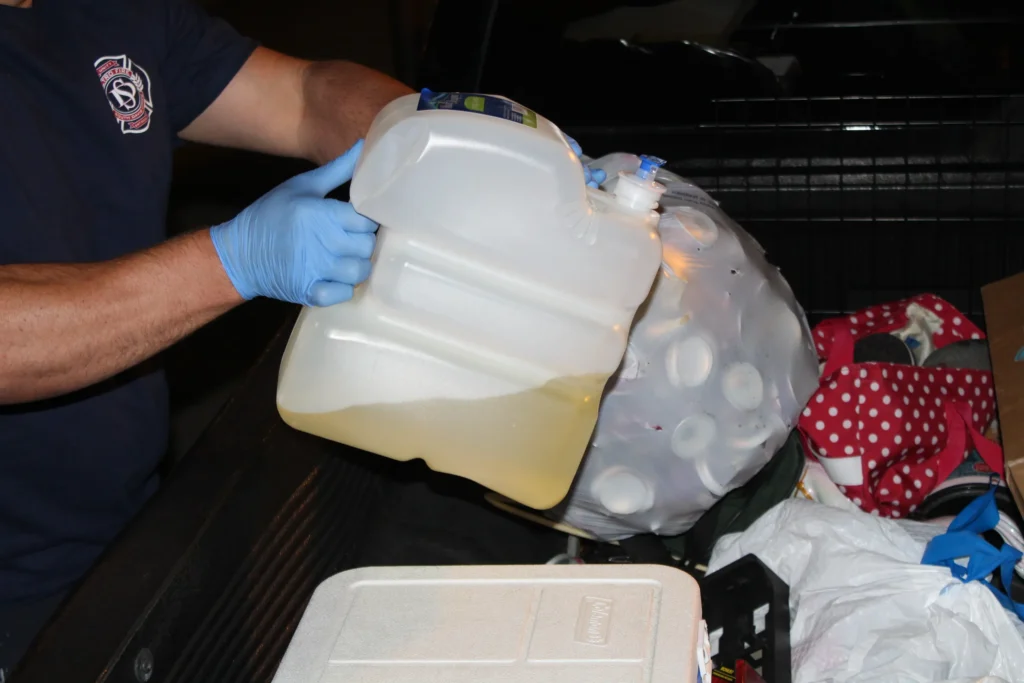
Investigators and Prosecution claim Ron started the fire in person. Yet, the Prosecution has not provided ANY evidence, video, or testimony substantiating that Ron was on the property around the time the fire ignited. Building footage shows that Ron left the building prior to the fire and did not return until the fire alarm sounded, and other evidence shows that he was not on the property when the fire ignited.
Investigators and Prosecution claim gasoline was used in the fire and that the gasoline came from a container in Ron’s truck. There is NO indication or evidence that Ron—or anyone else—transported any liquid (flammable, or not) in any container from Ron’s truck to the scene of the fire. There is NO forensic report stating that gasoline was used as the accelerant of the fire. The Defense has not received such a report.
And if it was a gasoline fire, why didn’t anyone report smelling gasoline inside the building, hear an explosion, or feel the tremor, which gasoline consistently presents? Why isn’t there any provided surveillance footage of anyone entering the fire area to distribute the gasoline, ignite the fire, and escape injury-free? Someone must have poured or spilled a flammable liquid through the fire area sometime between 10:10 and 11:47, but where is any footage of that person or anyone else entering or exiting that area within the rational time period of the fire ignition and fire alarm? The Defense has not received any record of anyone entering the fire area within that time range.
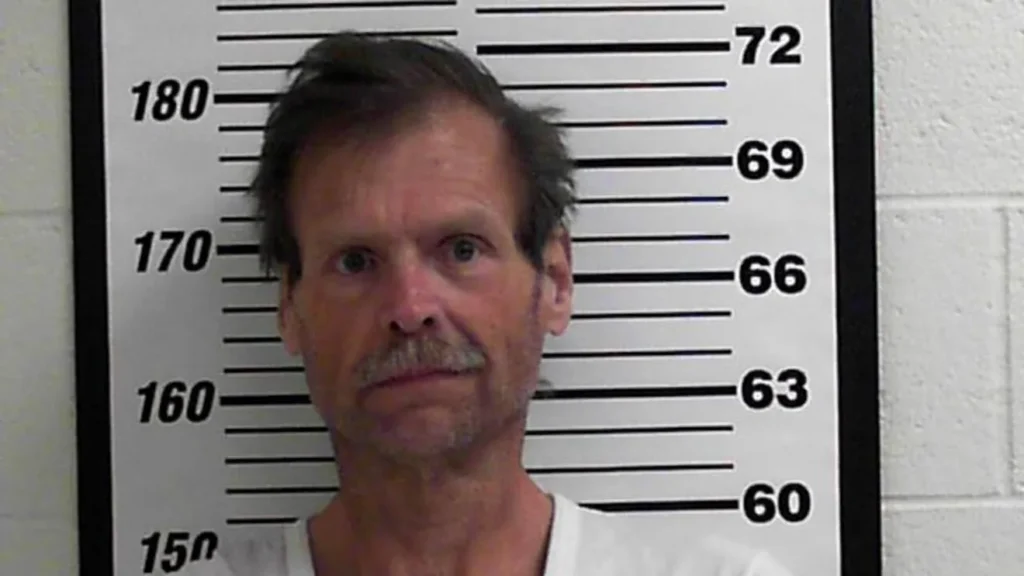
Ron Makin was accused of starting the Meadows Carpet Fire because he smelled like gasoline and had a gas jug in his truck. But the fire didn’t burn at all like gasoline, no one reported smelling gasoline inside the building, and Ron wasn’t even near the building around the time of ignition.
Case’s Main Points
- Event — the evening of May 19, 2018: a small fire on a carpet in a public hallway and stairwell of the Meadows Apartments (285 E 1450 N, Bountiful, UT), for low-income, disabled residents. The fire was only a few inches in height, at most!
- Someone (not Ron Makin) leaked an alcohol-like flammable liquid along that hallway and stairwell, which leads to an outside dumpster, but no surveillance footage has been provided to show who accidentally leaked the liquid, though the surveillance camera system was operational. This leak must have occurred within moments before the fire’s ignition.
- Without forensic evidence or other evidence, investigators strongly implied it was a gasoline fire. The actual evidence disproves their claim.
- Investigators claim, without evidence, it was arson, but the actual evidence disproves their claim.
- Though the Defense received some of the surveillance footage, the investigators and Prosecution have not provided any building surveillance videos, forensic findings, testimonies or any other evidence to plausibly indicate that Ron Makin was in any way involved in starting the fire or that he was even around the building at the time of ignition.
- Investigators accused Ron Makin of starting the fire, contrary to all the overwhelming facts that Ron had nothing to do with it.
- Ron accidentally spilled gasoline on himself two hours (~9:45pm) prior to the fire, at a church parking lot while moving jugs around in his truck, to fill jugs with drinking water at the church’s water well. Ron’s defective pacemaker shocked him as he exerted himself, causing a painful muscular spasm as he tried to move a partially-filled gasoline jug (having an unsecured lid), causing him to spill gasoline on himself.
- Ron smelled like gasoline residue, due to the gas spill just mentioned.
- Ron is neurologically and communicatively challenged. Investigators therefore claimed that his narrative of his actions that night seemed inconsistent and didn’t make sense to them, so they charged him with obstructing justice.
- Ron was charged with Aggravated Arson and Obstructing Justice. Court Case #181701041: “STATE OF UTAH vs. RONALD WAYNE MAKIN”
A Carpet Fire?!
There was minimal fire damage. It was just a relatively minor carpet fire, definitely not indicative of arson and definitely not indicative of a gasoline fire.
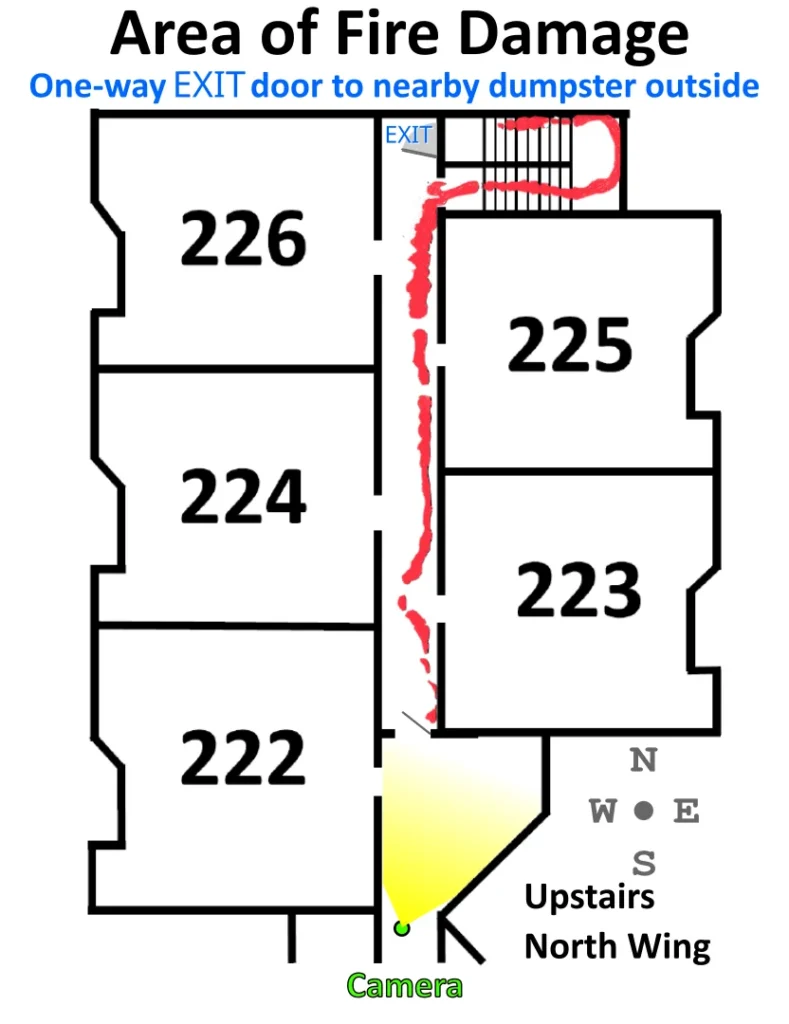
The only access into the area of the fire—the north, upper hallway and adjacent stairwell—is from the south (mezzanine common). The stairwell exits to the outside through a one-way door that can’t be opened from the outside. Notice in the image below that the supposed arsonist “seems” to be right-handed, incapable of committing arson on the left side of the hallway or the inner edges of the stairwell.
Surveillance of the Fire Area (Cam15)
Notice that the record received from the Prosecution is incomplete. Ron is shown passing through the pre-fire area at 10:07pm then at the building’s main door at 10:10, but the next provided footage of the fire area—1 hour 40 minutes later—is at 11:47 when the fire alarm activates, after the fire has been burning for a while. Obviously, someone spilled a flammable liquid in that hour-and-forty-minute gap through the fire area, but there is no provided footage to indicate that anyone entered or exited the area.
Does the evidence suggest deliberate arson, or simply someone’s clumsy, accidental static-electric ignition of a garbage spill on their way to the dumpster? Curiously, the spill began behind the hallway’s automatic door. This trivial fire was caused by a flammable fluid, drizzled and dripped through the hall and down the stairs toward the outside walkway, which leads to the dumpster. Beyond the drip’s wetted area, carpets didn’t burn and paint did not blister but only collected soot (condensate) because the walls were cool or cold.
Only one occupant had to (simply) step over the flames. Two others exiting their apartment simply walked beside the small, non-threatening flame to exit the 56-ft long and 5-ft wide hallway, unthreatened and unharmed. They required no medical attention.
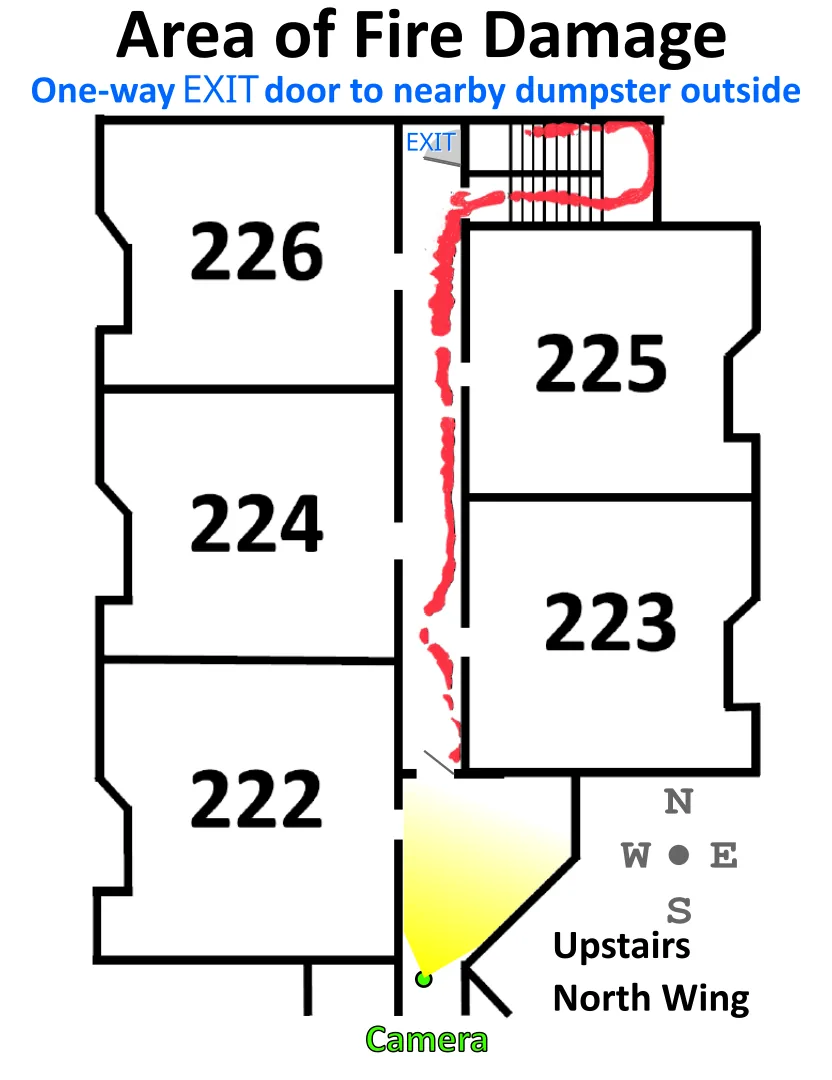
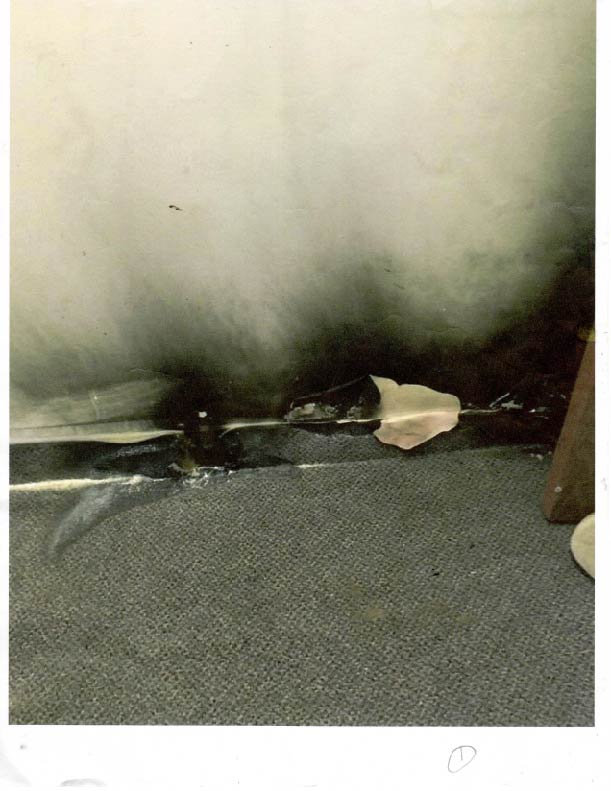
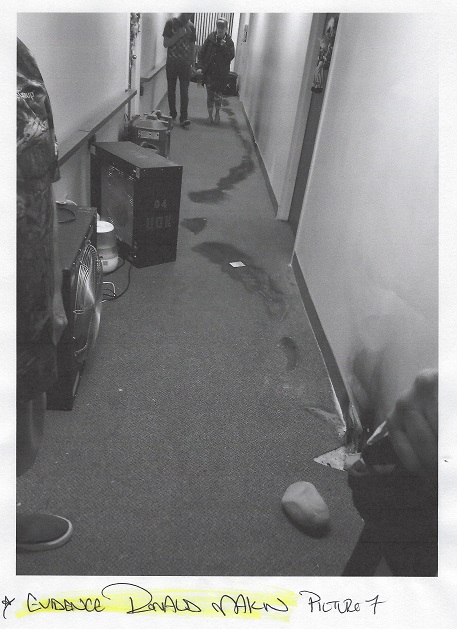
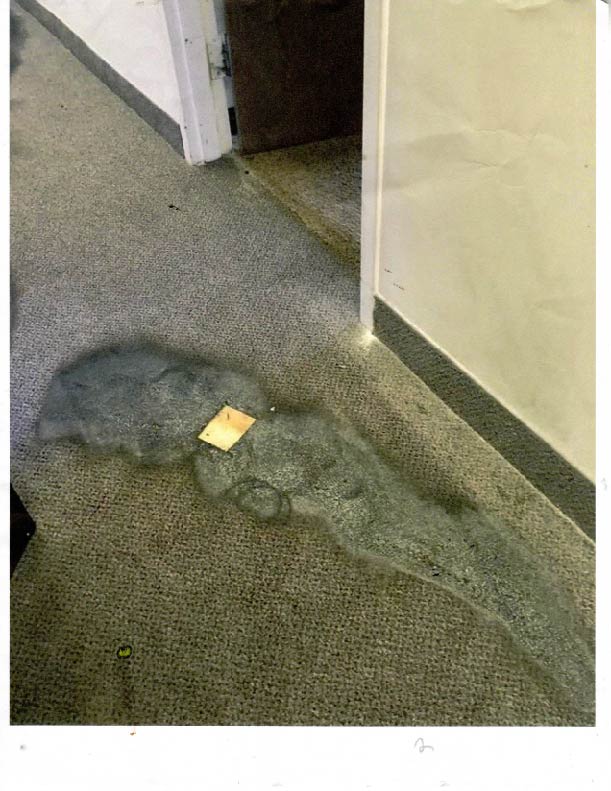
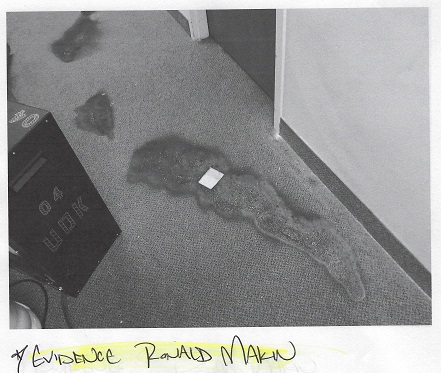
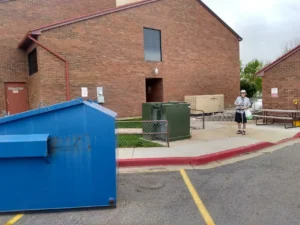
Bountiful City Police claimed that this fire was a premeditated arson fire and insinuated that the accelerant was gasoline, specifically from a water jug which contained gasoline. But why would an arsonist return his NOT–empty gasoline jug back to his pickup truck—where everyone could see it—after supposedly pouring some of the fuel for the “arson” fire? The claims of “arson” and “gasoline fire” just don’t add up to the absence of fire ferocity or damage shown in the Meadows Carpet Fire. There’s simply no evidence to support those claims or that Ron was involved in starting the fire. Prosecution and investigators haven’t provided any evidence, facts or explanations of their processes to validate their claims.
A gasoline fire is violent and ferociously damages everything within its domain. How could anyone using gasoline and igniting it—deliberate arsonist or not—utterly fail to cause catastrophic structural damage to this apartment building? The only possible answer is that it was not a gasoline fire in the first place, and it certainly was not deliberate!
History of the Gasoline Container in Ron’s Truck Bed
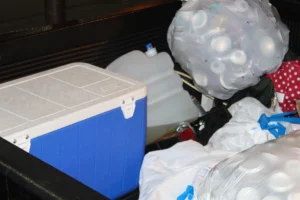
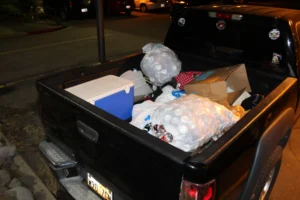
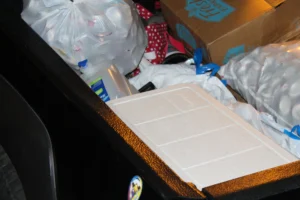
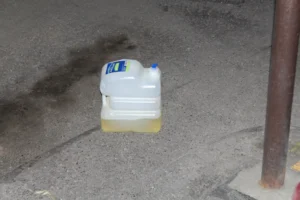
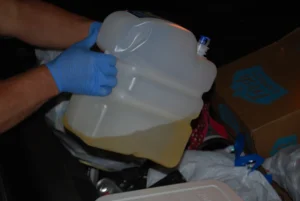
The gasoline container, shown above, was alleged to be the source of the accelerant used in the Meadows Carpet Fire, even though forensic chemistry indicates no gasoline was used as the accelerant in the carpet samples.
Three days prior to the fire (Wed, May 16), Ron was asked by his estranged ex-family associate to carry this gasoline-filled water jug, which Ron accepted, unaware that the container was unapproved for gasoline. (The acquaintance operates a property maintenance service and wanted to carry more than his DOT-approved containers could hold or conveniently distribute.) After the acquaintance placed the container in the back of Ron’s truck, he assured Ron that he would come over to Ron’s apartment at the Meadows and retrieve this unapproved container which he used in his lawn care service. For three days Ron drove around with this gasoline container, not realizing that the cap was insecure as provided.
A few hours (~9:45pm) prior to the fire Ron went for coffee (mocha) and then went for well water at the Centerville church parking lot adjacent to the 200 S 200 E intersection. He reached forward to lift the 2.5 gallon water container filled with gas (left with him by the ex-family associate) out of the way to access his regular water bottles in the back of his truck.
Under the exertion of lifting the approximately 15-lb container of gas, Ron’s defective pacemaker was shocking him and giving him spasm-inducing stress. Because of the pain and destabilizing effect caused from the pacemaker, his actions were not stable; and because of the unsealable, insecure cap, he spilled a considerable amount of the container’s gasoline onto his pants, shoes and the parking lot asphalt.
The location of Ron’s gasoline spill: approximately the center of the church parking lot. Other cars were parked close to the water well, so Ron parked away from the well. The gasoline spill damaged some of the asphalt, which damage was still recognizable for many months.
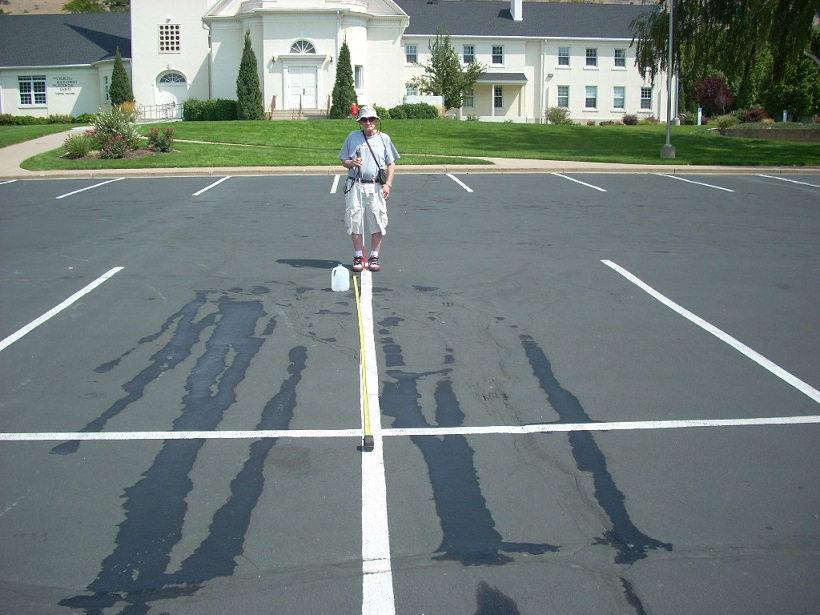
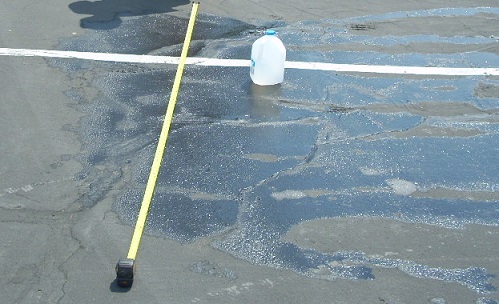
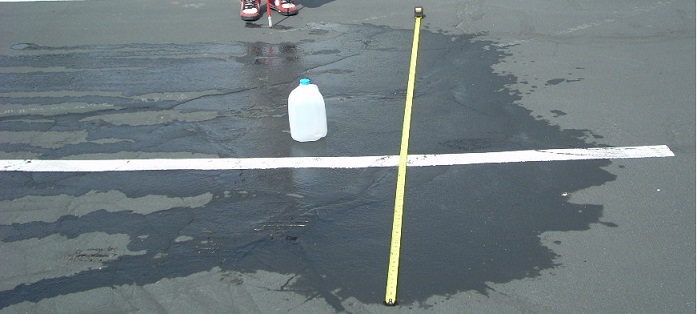
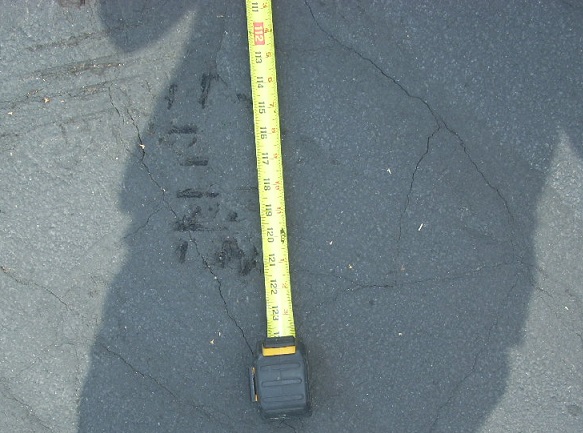
Ron then walked with his dogs around the water well’s/church’s parking lot for a few minutes to allow the gas to dry, since he didn’t have a change of clothes or shoes, until the gas had evaporated, and then he returned with his coffee and dogs to the Meadows parking lot. This all happened ~9:45pm, about 2 hours before the fire.
At about 10:20 (footage not provided) Ron took the dogs for a short walk, having not changed his clothes and not realizing that he still smelled like gasoline residue. He returned to his apartment with the dogs at ~10:40 (footage not provided). He spent some time in his apartment with his wife Susie and then went for another walk (without his dogs) at 11:15, wearing the same gas-smelling T-shirt, pants and shoes he was wearing earlier. Surveillance shows him leaving the building and does not show him again until 11:47. Walking around the block for about 1.1 miles—and witnessing a distant traffic stop at ~11:35—he returned to the building about 11:47, just as the fire alarm sounded.
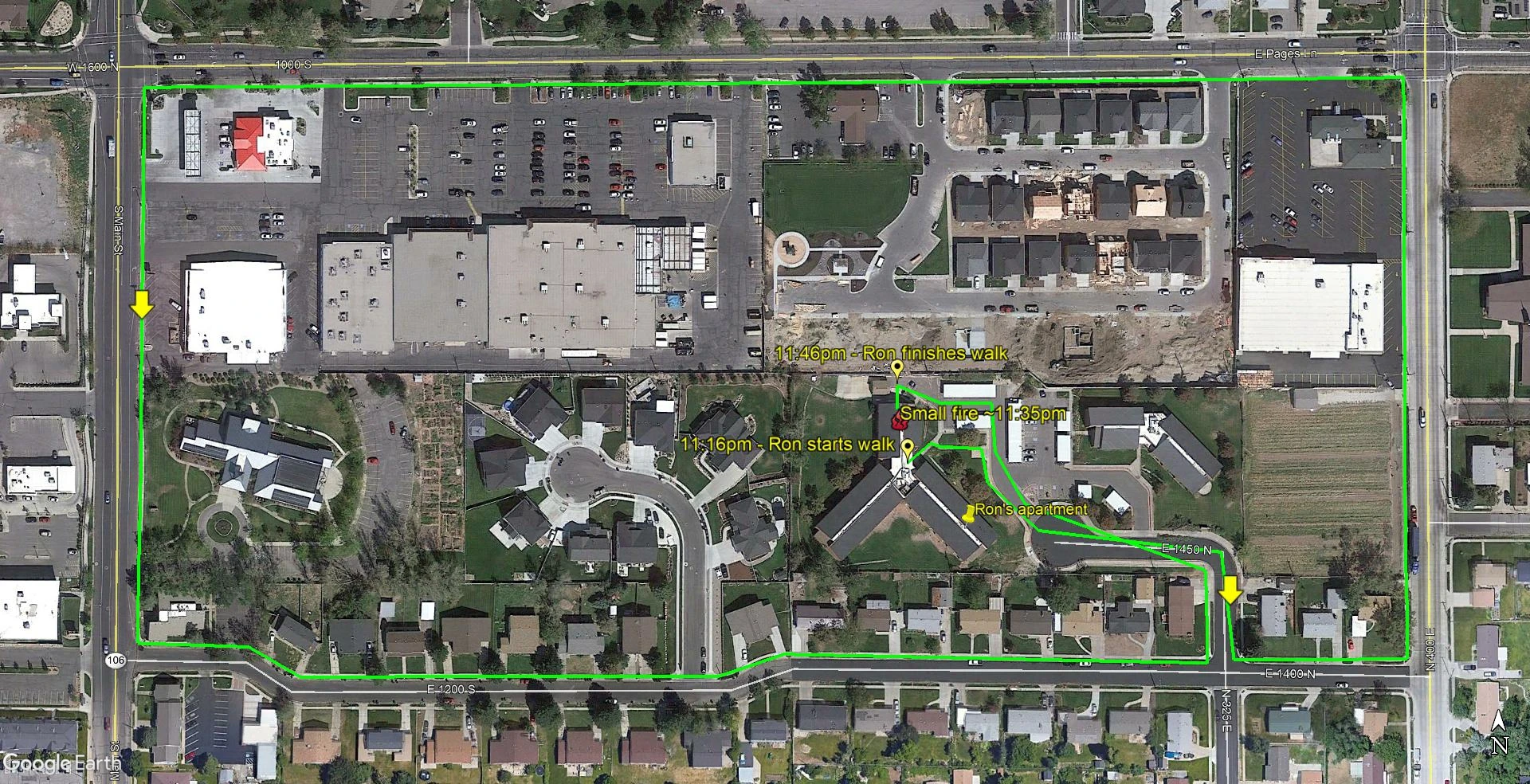
The “small” fire, as described by several residents, obviously started before Ron entered the building, since the alarm sounded within seconds after he entered the building. He immediately went to his apartment and advised his wife Susie to get dressed in order to leave the apartment. He then picked up his phone which he hadn’t taken with him on his walk. Ron then stepped into the hall with his dogs in tow and called 911 while searching for the fire. The operator asked him if he saw any flames. After Ron located the fire in the north wing from the mezzanine (footage not provided), he reported that he could see flames and the operator told him to evacuate the building.
The surveillance footage of Ron locating the fire and reporting seeing flames to the 911 operator (11:47:32-11:48:12pm) has not been provided by the Prosecution, but the audio of his 911 call has been provided.
The mezzanine camera shows Ron entering his southeast hallway from the mezzanine at 11:47:30pm, to retrieve his phone from his apartment so that he could call 911 and locate the fire. To locate the fire, Ron had to reenter the mezzanine camera’s field of view a few moments later, but the footage of Ron locating the fire has not been provided. Why???!!!—the fire was already burning; he had already entered the building; and whether Ron had started the fire or not, he had absolutely no reason to hide his location or be in a place other than the mezzanine where he purported to be when he reported seeing flames.
Ron was already trained previously as a first responder for fire and rescue, so his first concern was to help those who had ambulatory disabilities. Ron’s wife informed residents while Ron assisted an amputee in securing their leg, and assisted a resident with a recent back injury out of the building. Ron then returned to the area of the fire, remembering to help the blind and deaf person in the apartment adjacent to the fire scene.
After Ron helped evacuate the less-ambulatory, he then put out part of the small, visible flames with the fire extinguisher foam before having to leave because of the acrid smoke from the incinerated carpet fumes. The rest of the fire burned itself out. The fire department arrived after the fire had already been extinguished.
As Ron walked in and around the building 2 hours after his accidental gasoline spill on himself near the church’s water well, still smelling like gasoline residue, it made him the secondary person of interest and, soon, the ultimate suspect. The police, fire personnel and apartment tenants noticed his smell. They conjured the idea that Ron was an arsonist.
All indications are that the fire was accidental and was caused by a low molecular weight/alcohol-like spill, liquor or household cleaning liquid, which was unintentionally ignited with static, friction, sparks, the flame of a smoker’s cigarette lighter, an ember from a smoldering cigarette, or a nearby 7.2 kV power transformer.
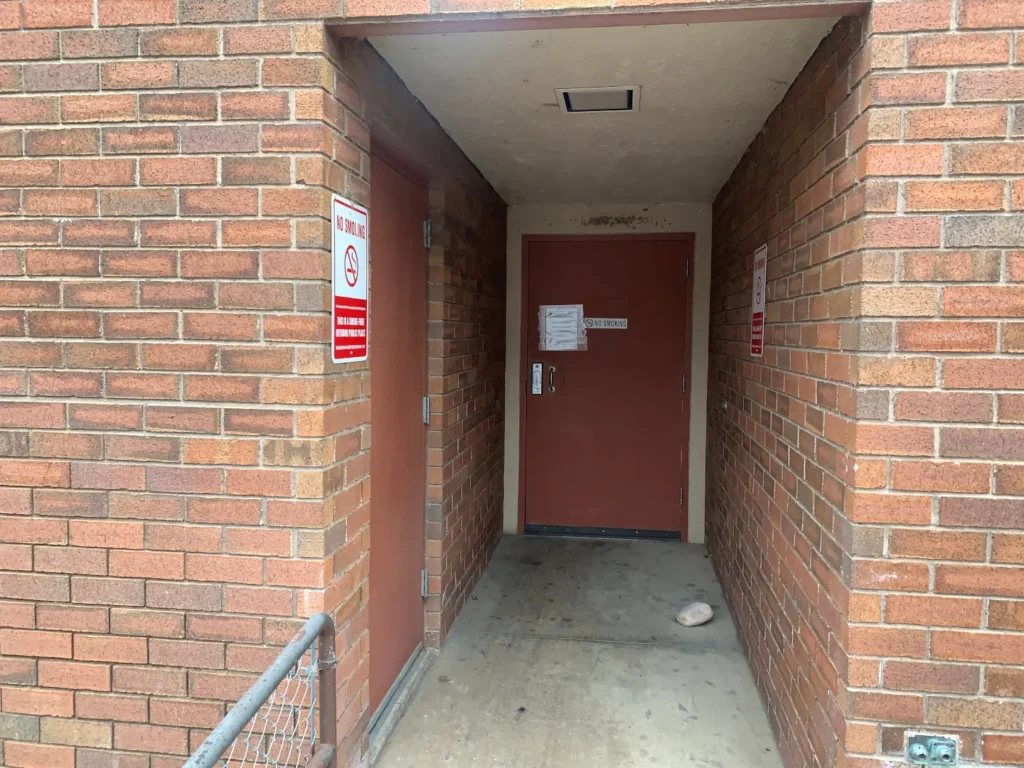

If a gallon of gasoline—or just a cup—had been distributed and spread throughout the hallway and stairwell, then ignited by some method, the ignition and explosion would have blown out all the windows and doors of that stairwell and attached upper hallway. That is called a “BOMB!” It would have seriously burned or killed the alleged, gasoline-contaminated arsonist and the individuals in apartments attached to that hallway. However, the individuals living in those apartments were not even aware of an ignition, explosion or fire, and only after the alarm sounded they walked out uninjured and unharmed. Had gasoline been used, the fire would not have burned out by itself before the fire department arrived.
Persons of Interest
Person of interest #1 (the initial suspect—the guy in the red shirt) The only other individual adversely affected by the fire was an individual who didn’t live in that hallway but was using that hallway and stairwell as a pathway to the outside dumpster to dispose of his garbage, as did others. A rock was found by the stairwell’s exit-only door, suggesting it was used to prop the door open to allow re-entry, as was often done.
As this man in red re-entered the building through that same stairway and hall, the flames apparently became evident underneath him. He apparently tried to stomp and pat out this trivial or nonthreatening fire. He likely panicked when he realized he could not put out the fire that he noticed during his passage up the stairs and through the hallway. This individual was treated and transported to the hospital by ambulance for serious smoke inhalation and possible heat irritations to his hands.
There is NO police and medical report of that person-of-interest #1—the initial arson suspect—who received those injuries. This person, who was staying with a friend at the Meadows complex, abruptly packed and left—that night—and has never returned to the facility since. He was the only person to receive medical attention and treatment at the hospital for any fire-related injuries that evening.
Person of interest #3 A heavy-set, young man wearing gray shorts and a blue T-shirt was noticed loitering outside near the stairwell’s fire-exit door and the fuel spill’s trail, possibly lighting up a cigarette in the stairwell and sneaking a quick smoke as many others did in this area, unwittingly igniting the combustible vapors.
Change.org Petition: Exonerate innocent Ron Makin for baseless arson charges! Read about Ron’s harrowing ordeal.